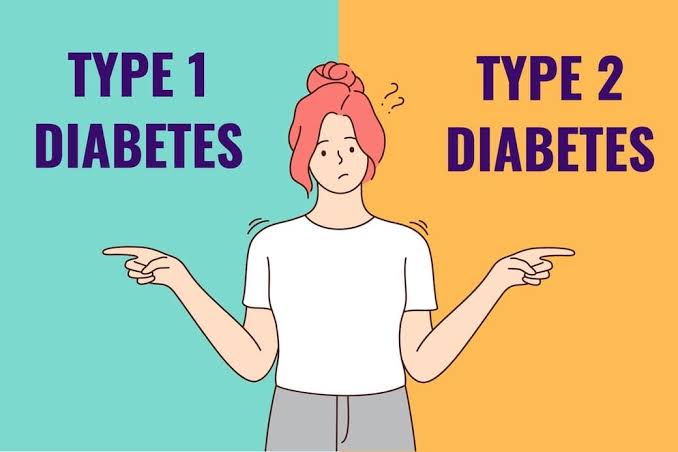Let’s start by answering the question of what is diabetes before we move on to how diabetics should eat. Diabetes (sugar disease) is a metabolic condition in which the body has difficulty regulating blood sugar levels. Basically, diabetes occurs when the body is unable to produce enough of the hormone insulin or to use the insulin produced effectively. Insulin is necessary to control blood sugar levels and to allow glucose (sec) into the cells.
There are two most common types of diabetes: diabetes:
Type 1 diabetes: The immune system attacks the insulin-producing cells in the pancreas and destroys these cells. As a result, the body cannot produce insulin and it is necessary to inject insulin from outside. Type 1 diabetes usually begins in childhood or young ages and can be genetically inherited.
Type 2 diabetes: Body cells cannot use enough insulin or the body cannot produce enough insulin. This type of diabetes is often associated with factors such as lifestyle factors, obesity, inactivity, and genetic predisposition. Type 2 diabetes usually occurs in adults, but it can also occur in young people.
Symptoms of diabetes may include excessive thirst, frequent urination, fatigue, weight loss, blurred vision, and slow-healing wounds. Diabetes can cause heart disease, kidney problems, nerve damage and other serious health problems in the long term.
Management of diabetes can include adopting a healthy lifestyle, regular physical activity, balanced nutrition, and medication or insulin therapy as needed. It is important for diabetics to monitor their blood sugar levels regularly and collaborate with health professionals. Now what is the difference between Type 1 and Type 2, let’s look for answers to questions like how to feed diabetics.
Type 1 and Type 2 are two different types of diabetes that occur due to different causes. Here are the main differences between Type 1 and Type 2 diabetes:
Cause
Type 1 diabetes: Type 1 diabetes is an autoimmune disease. The immune system targets and destroys insulin-producing cells (beta cells) in the pancreas. Therefore, the body cannot produce insulin.Type 2 diabetes: Type 2 diabetes is often associated with insulin resistance. Cells in the body react less to insulin than normal and cannot fully utilize the action of the insulin produced by the pancreas. Over time, the pancreas can reduce insulin production.
Age of emergence
Type 1 diabetes: Type 1 diabetes usually begins in childhood or young adulthood, but can occur at any age.Type 2 diabetes: Type 2 diabetes usually occurs during middle age or advanced age, but there has been an increase in recent years among young people and children. Obesity and lifestyle factors increase the risk of Type 2 diabetes.
Insulin production
Type 1 diabetes: People with type 1 diabetes do not have insulin production in the body because the beta cells in the pancreas are damaged. Therefore, people with type 1 diabetes need to use insulin injections or an insulin pump.Type 2 diabetes: The pancreas of people with type 2 diabetes usually continues to produce insulin, but the cells in the body cannot use insulin effectively. It may be possible to control blood sugar with oral medications at the first stage, but insulin therapy may be needed in the following cases.
Lifestyle factors
Type 1 diabetes: Type 1 diabetes is usually not directly related to lifestyle factors, as it is an autoimmune disease.Type 2 diabetes: Type 2 diabetes is closely related to lifestyle factors such as obesity, sedentary lifestyle, unhealthy diet, genetic predisposition.
Treatment
Type 1 diabetes: People with type 1 diabetes need lifelong insulin therapy. Insulin injections or insulin pump are used. It is also important to monitor blood sugar, pay attention to diet and do physical activity.Type 2 diabetes: Lifestyle changes in the treatment of type 2 diabetes (healthy diet, weight loss, regular exercise) are of great importance. Oral antidiabetic medications may be used in the first stage. In advanced cases, insulin therapy may be required.
Given these differences, we can say that Type 1 and Type 2 diabetes have different causes, age groups, insulin production and treatment. Proper diagnosis and management are important as both conditions can lead to serious health problems.
How should diabetic patients eat?
For people with diabetes, healthy eating is crucial for controlling blood sugar, maintaining weight management and maintaining overall health. Here are some nutritional principles to consider for people with diabetes:
Keep carbohydrates under control: Carbohydrates directly affect blood sugar, so individuals with diabetes need to carefully manage their carbohydrate consumption. Prefer fibrous, complex carbohydrates rather than fast-digesting carbohydrates. By opting for foods high in fiber, such as whole grains, vegetables, fruits, you can control your blood sugar more steadily.
Portion control: Controlling food portions can reduce the risk of overeating. Limit your portions, especially in high-calorie or high-carb foods.
Prefer healthy fats: Choose unsaturated fats instead of saturated fats. Focus on healthy sources of fat such as olive oil, avocado, nuts, seeds.
Protein balance: Protein can increase your feeling of satiety and help in maintaining muscle mass. But avoid excessive protein intake, as this can also raise blood sugar.
Balanced meals: Eating meals at regular intervals can help you control your blood sugar more consistently. Avoid prolonged hunger.
Sugar content control: Avoid refined sugars and sweeteners. You can use sweetener alternatives when needed.
Fruit consumption: Fruits are healthy but naturally contain sugar. When consuming fruit, check portions and opt for fruits with a high fiber content.
Limit your salt intake: Excessive consumption of salt can increase blood pressure. Avoid processed foods and salty snacks.
Do not forget to drink water: Drinking plenty of water both provides hydration and supports metabolic functions.
Watching the diet: Keep in touch with your health care professional regularly to monitor blood sugar levels and overall health.
For individuals with diabetes, nutrition may differ based on individual needs and health status. This is why it is important to create a personalized eating plan by working with a dietitian.

